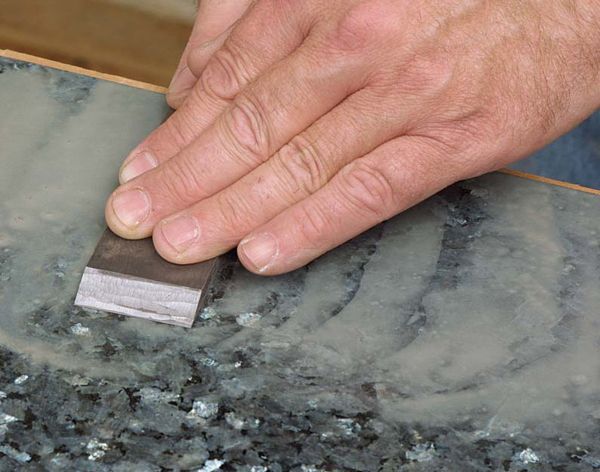Sharpening – A Different Approach
Powdered abrasives on granite are quick, efficient, and economical
Synopsis: If you haven’t had sharpening success or want to explore a new method, try honing your blade on granite with a water and silicon-carbide slurry. The method is economical and effective, and how-to instructions are included. Also, when choosing your grinding wheels for reshaping tools in bad condition, consult this small guide to abrasives, colors, and size.
From Fine Woodworking #165
I’ve accumulated a motley collection of handplanes and chisels over the years. Some are decent tools (a set of Stanley chisels made in the 1940s), some are strictly utilitarian (solid-steel Klein chisels made for electricians who need to chop out floor joists), and until recently, none of them were razor sharp.
As a matter of fact, I confess that I’ve used those chisels to open paint cans rather than walk the length of the shop to retrieve a screwdriver. In the never-ending debate of hand tools versus machine tools, I’ve always leaned heavily toward the latter. On an average day, you’d find my jointer knives in a lot better shape than my handplane blades.
To me, sharpening always seemed to be a dreadful chore—in part, I think, because I never had the luxury of a good instructor. Also, I was using some of the wrong equipment. I had bought a 3,600-rpm grinder that came with two silicon-carbide wheels. If I were buying a new grinder now, I’d get an 1,800-rpm machine. For stones I owned a cheap oilstone with a medium grit on one side and a fine grit on the other. I destroyed a chisel by overheating it the first time I used the grinder, and it wasn’t long before the oilstone, which sat out on a workbench, got clogged with fine sawdust and dished in the center on both sides.
In no time and out of desperation, I turned to my 6-in. edge sander to sharpen the edges of chisels and plane blades. Call it overkill, but a worn 120-grit belt on the edge sander worked well enough to bring a really dull edge back to a point where it could at least cut wood.
In the process of organizing a new basement shop and fed up with dull tools, I decided to improve my sharpening setup. Of all the articles about sharpening that this magazine has published over the years, the one that intrigued me most was in FWW #140, and it documented Mike Dunbar’s system of sandpaper glued to a 3⁄8-in.-thick by 40-in.-long piece of glass. I liked his no-nonsense approach toward keeping tools sharp. But considering some of the obvious consequences, even Dunbar’s method had its drawbacks for me. My new basement shop is small and has a concrete floor—40 in. of bench space is a lot of dedicated real estate in a small shop, and it’s not hard to envision a future of sweeping up shards of broken glass.
For the full article, download the PDF below.
Fine Woodworking Recommended Products

Dustopper Pro

Honing Compound

Estwing Dead-Blow Mallet





















Log in or create an account to post a comment.
Sign up Log in